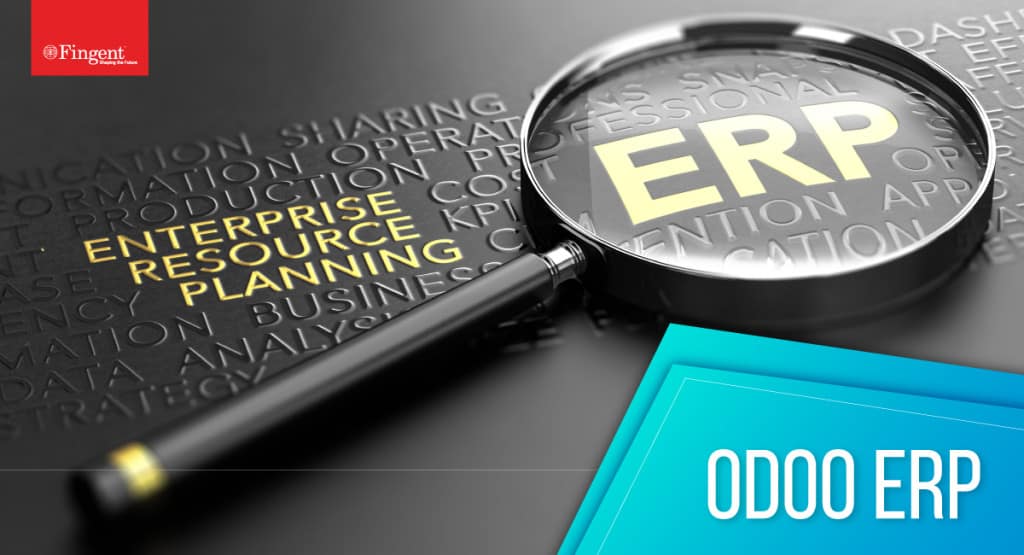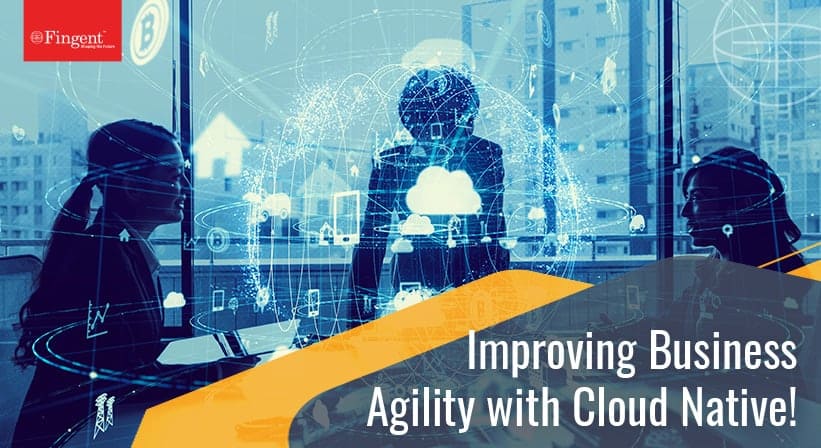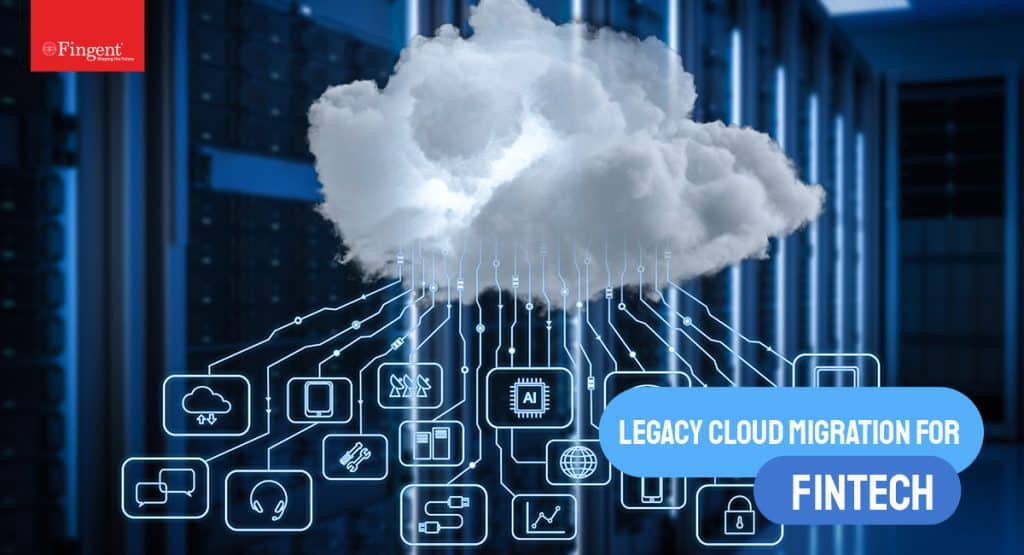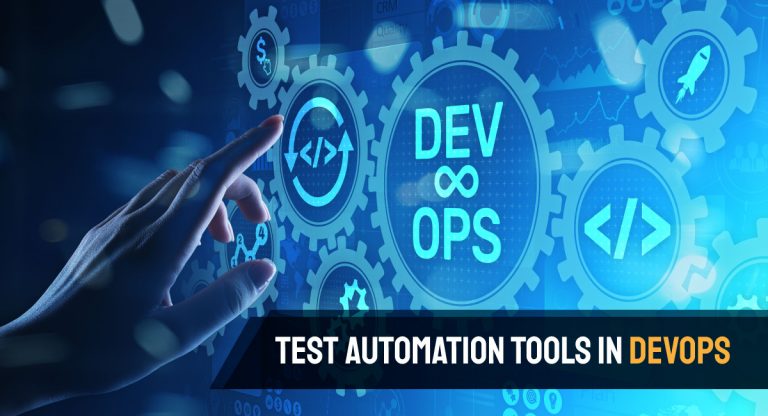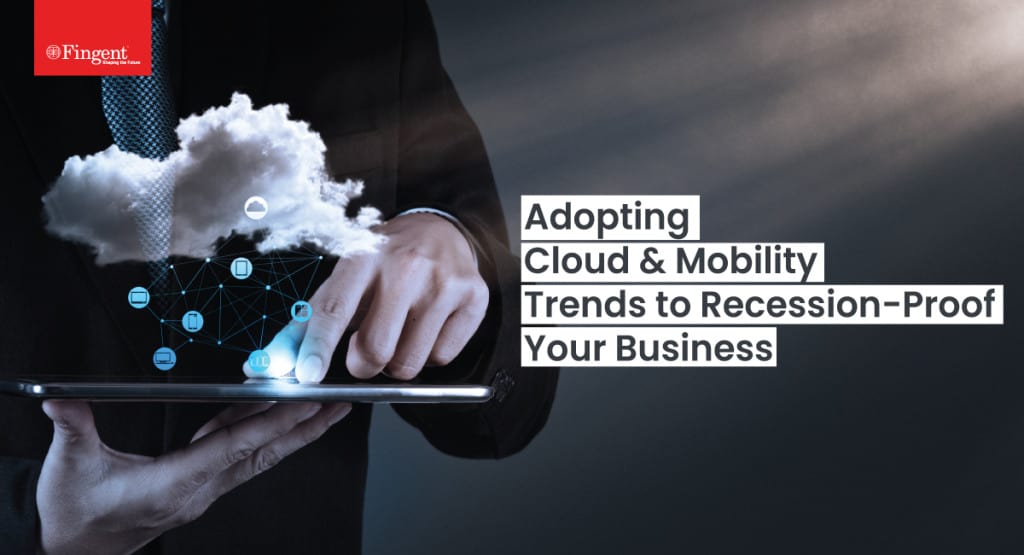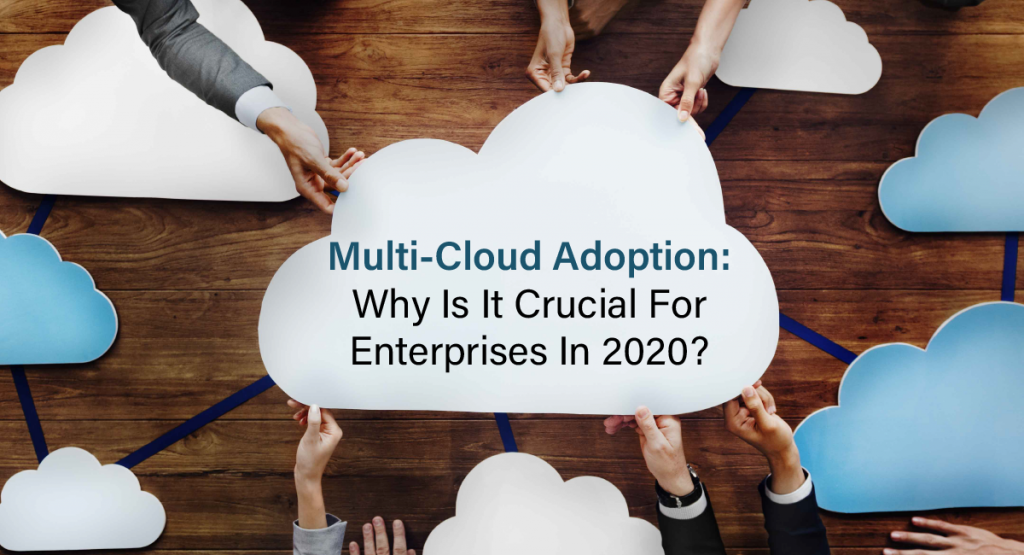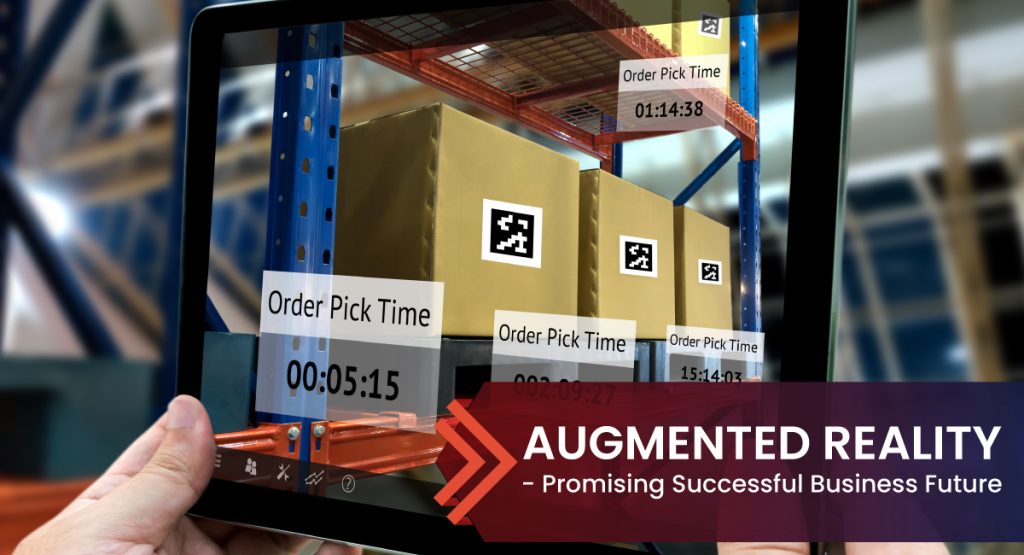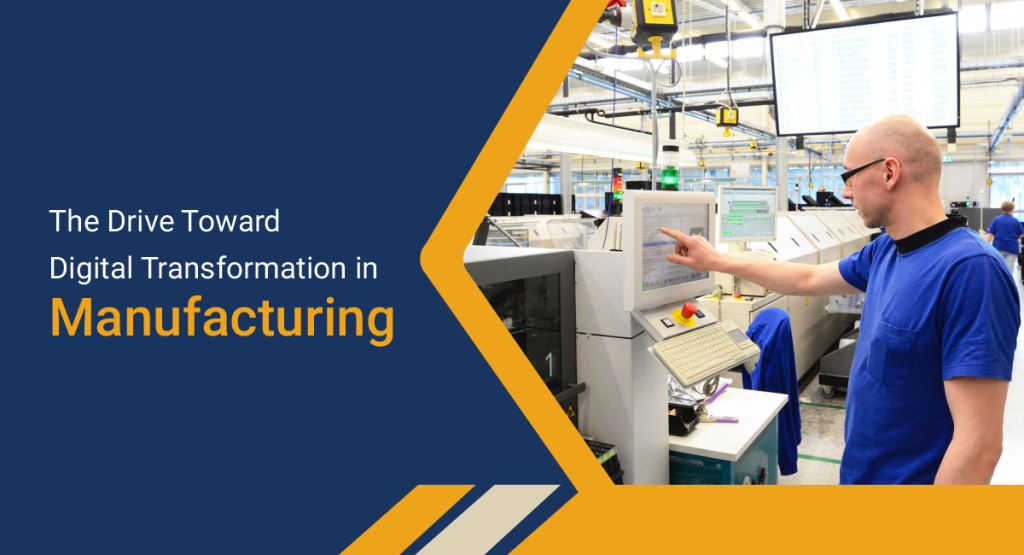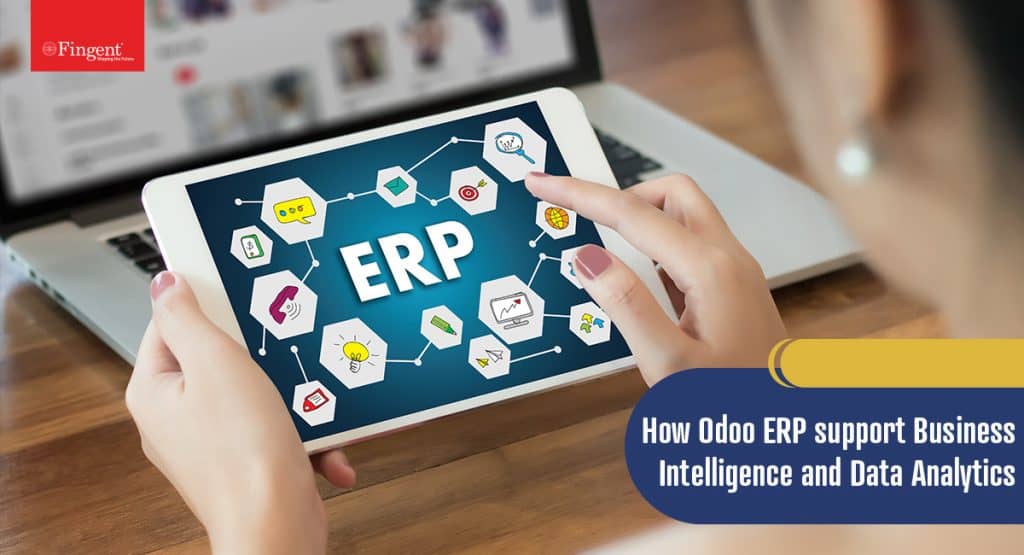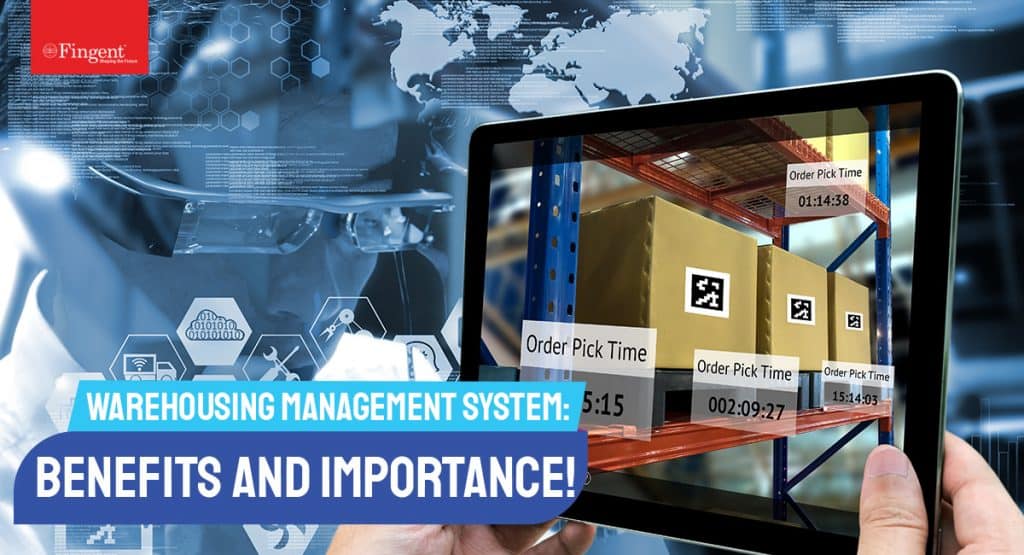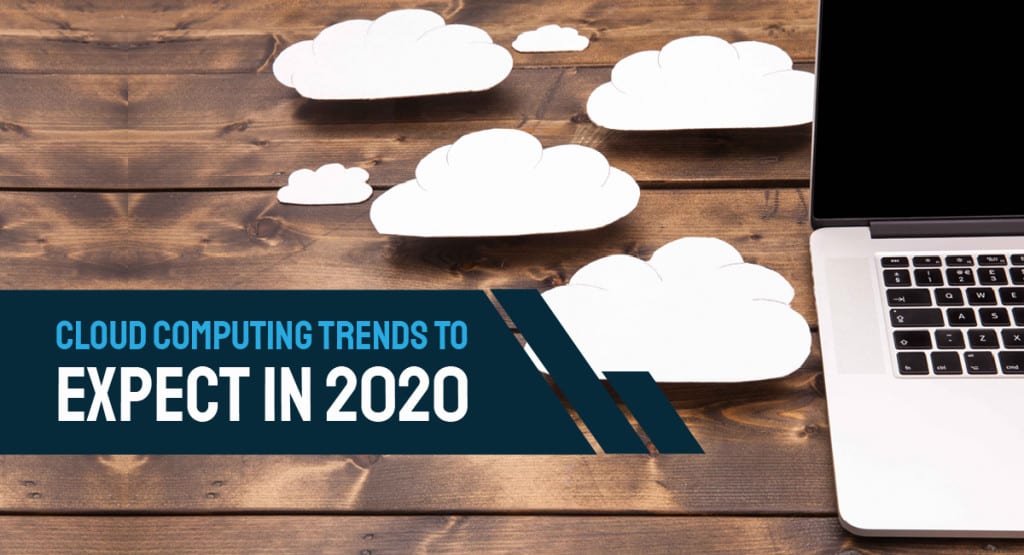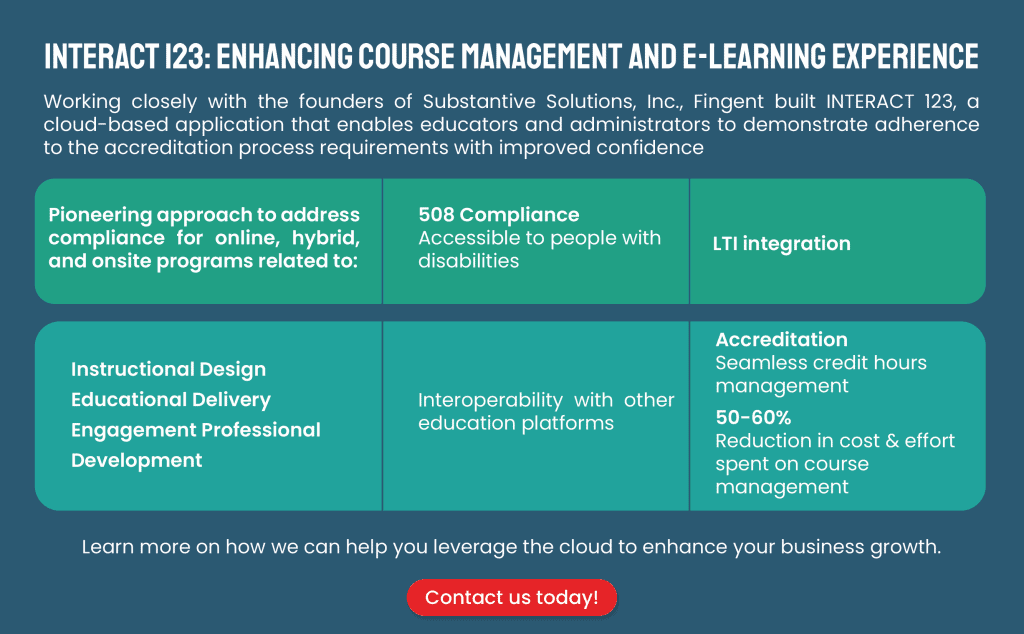Category: Digital Transformation
Businesses today need a reliable, effective, and user-friendly support system to tackle the rapidly evolving market changes. Odoo ERP offers features and easy-to-use models that enable businesses to simplify their processes, reduce costs and improve efficiency. It also offers free and paid versions with an outstanding integrated system providing businesses with reasonable flexibility and scalability. With these and many other unique capabilities, Odoo ERP is turning into a hot topic amongst top companies today! With the release of Odoo 15, expectations have risen even more! Businesses are strategizing ways in which they can deploy the improved capabilities of Odoo 15 to enhance their business growth. This blog will take you through what’s new in Odoo 15 and how you can leverage these enhanced features for your business.
What is Odoo 15?
The all-new Odoo 15 is likely to launch in October 2021. It will be released in the Odoo Experience Meet which will be conducted virtually due to the COVID-19 pandemic prevalent in many parts of the world. Odoo 15 is expected to feature advanced tools that can help improve business performance and efficiency. Odoo 15 is believed to be the ultimate business solution with its latest web-based integration and superior architecture.
Read more: 5 signs which imply that your business needs Odoo ERP
A Look Into the Expected Features of Odoo 15
1. New import screen
Odoo 15 is expected to extend the experience with its new importing screen feature. This new import screen feature includes a menu to handle cash rounding making it seamless for accounting and generating the invoices.
This feature is expected to be available in all the required modules and functional tabs.
2. Capable options in Pivot and Graph views
Odoo ERP software provides data representation with Pivot and Graph views. The Odoo 15 version will most likely allow you to edit and adjust the graph using Odoo studio. With this, you can extend the representation of the data to valuable insights for improved decision-making and analysis.
3. New HTML Editor
Odoo 15 is expected to include an attractive new HTML editor. While it will be similar to text editors, it will include HTML codes. So, many developers are using it to extend productivity.
4. Coupon and Promotion Program in POS
While the previous versions of the Coupon and Promotions were exclusively for Sale and eCommerce websites, the Odoo 15 coupons is created to support both eCommerce as well as POS.
The feature will be available in the POS settings. While under the product menu you will have the option to create Coupons and Promotions based on your business needs for later use. The cashier can click on the Enter Code button from the POS and apply the Coupons for Point of Sale Order which will be reflected in the customer’s invoice.
Considering the previous trends of Odoo releases, Odoo 15 will have an enhanced user experience that is sure to blow your mind.
5. New command and command editor
Odoo 15 will include the new command and command editor. It will help handle invoices in accounting configuration.
Read more: How Odoo ERP Simplifies Sales Management in Your Organization
6. CRM
The new feature in the CRM is expected to improve managing leads and well assigning salespersons.
Using this feature, leaders can allocate the desired team members to activity or lead in the Odoo 15 CRM module. This will augment the organization’s sales activity and the team members’ collaboration for the leads.
7. Project burn down chart
This feature will be introduced in the Project section. Here, you will find an easy reporting tool to view the actual chart of the project’s progress phase-wise.
Additionally, the chart will help identify the current trend and any delay for the project deliverable.
8. Share buttons
The share functionality will be included in the customize section of the eCommerce website platform.
Typically, the share button allows the products to be shared on different social media platforms through the website portal. Using the new functionality, you can share the details on the platform to finalize the product.
9. Purchase dashboard
The purchase dashboard gives an amazing perspective for the dashboard comprising all the purchase values and graphs. The dashboard provides the needed information about the tax and untaxed-based total. A click on the reporting tab of the Odoo 15 dashboard will seamlessly get you a detailed report.
10. Website gift card
This option allows you to sell the card on eCommerce. This functionality creates unique codes for the sale of Gift Cards. These unique codes are given to the customers either via email or physically.
Odoo apps or modules help create multiple unique codes for the purchase of a gift card. Odoo 15 is likely to upgrade these features.
Additional features
In addition to the above-mentioned features, Odoo 15 is likely to incorporate these features as well.
- Business Intelligence Tools
- A newly designed eCommerce product page
- Formulas of BOM, %of final products, etc., to improve the process manufacturing.
Read more: Why Choose Fingent as Your Odoo ERP Partner
Conclusion
Odoo ERP implementation can help you manage your business seamlessly and with Odoo 15 you can enhance it further with customization. In general, Odoo 15 brings several opportunities to users and developers and helps them explore better opportunities.
At Fingent, we constantly indulge in building innovative modules for Odoo and other ERP platforms. The rising capabilities of Odoo are sure to unlock unique opportunities and we are preparing businesses to deploy the same.
If you think your business is ready to deploy the rising capabilities of Odoo, then connect with our experts today, and explore unlimited possibilities for your business!
Stay up to date on what's new

Featured Blogs
Stay up to date on
what's new



Talk To Our Experts
Digital transformation was already happening across every industry, but the pandemic has accelerated the pace. Unfortunately, while many organizations have embraced the reality of rapid change, some of the companies have been slow to adopt new technologies.
Looking specifically at cloud solutions, companies that migrate some or all of their digital assets to the cloud can achieve transformational results. It is helping companies to innovate faster, modernize outdated infrastructure, get better insights from their data, scale globally, and restructure the existing business models to create better customer experiences.
Cloud migration allows easy access to data and applications from anywhere, making business functions smoother and simple to operate. This blog will help you understand why you need cloud migration now and the drivers that boost legacy cloud migration.
Why should you consider migration to the cloud?
Cloud migration can improve the performance and competitiveness of your organization. Often, system performance is poor, and maintenance costs are high. Any incompatibility with new technologies can cause problems when altering these systems as they cannot keep up to date at the same speed at which your business needs to innovate and scale. Additionally, lack of vendor support and regular updates for old systems can compromise the data security, making application migration to the cloud imperative.
Read more: Cloud Migration Strategy: 7 Steps to Accomplish a Flawless Transition
Common challenges associated with cloud migration
Cloud migration can be complex and risky, and many organizations face challenges during the transition.
1. Poor strategy and planning
Many organizations migrate to the cloud without proper planning or a good strategy. For a successful cloud implementation, organizations must plan well. As every application and dataset has different requirements, they will need a different approach to cloud migration. So, enterprises must have a valid business case for every workload it migrates to the cloud.
2. Vendor lock-in
This is a common problem faced by organizations that adopt cloud technology. While cloud providers offer many services, these services sometimes cannot be extended to other cloud platforms. Many organizations that start using cloud services often find it difficult to switch providers if the existing provider does not suit their requirements.
3. Data security and compliance
Data security and compliance are major obstacles to cloud migration. Cloud services often use a shared responsibility model in which they take the responsibility of securing the infrastructure while the organization takes responsibility for security data and workloads. It means you are responsible for configuring the security measures correctly and ensuring that all services and applications have proper security controls.
4. Cost Management
Many companies don’t have clear KPIs to understand what they plan to spend or save after migration, making it difficult to know if the migration was successful from the cost point of view. Additionally, as the cloud environment is dynamic, the costs can change as new services are adopted, and application usage grows.
Read more: A Comprehensive Guide To Modern Cloud Application Development
What are the drivers that encourage cloud migration?
1. Hassle-free digital transformation
With recent advances in cloud computing, leaders can digitize their core functionalities such as SAP, CRM, data analytics, and more. From innovating to improving productivity to unlocking new sources of revenue, the cloud provides endless opportunities to enterprises that migrate away from legacy systems.
2. Accelerate growth
Whether it is organic expansion, mergers, or acquisitions, technology is accelerating organizational growth. Organizations leveraging the cloud can integrate new acquisitions seamlessly with the existing platforms and also scale rapidly using auto-scaling functionality and flexible data management services.
3. Better Security
Data security is turning significant. By migrating to the cloud, enterprises can update their IT infrastructure according to the latest practices and protect their applications from malicious hacking attempts.
While many leaders mistakenly think that the cloud itself makes an organization secure, in reality, it empowers groups to implement governance, strict security policies, and compliance guardrails needed for their operations.
4. Improve business agility
To stay ahead of your competitors, you must be agile. It means you need to have access to flexible and on-demand IT resources. With the cloud, over 99% of resources are available on-demand. Also, enterprises don’t have to wait endlessly for any hardware component and installation. They can lease valuable capabilities from their cloud providers and get to the market faster.
5. Reduce costs
Yet another reason for businesses to migrate to the cloud is to reduce IT costs. You can easily find the right-size resources in the cloud according to your business needs and cut unnecessary costs. Also, companies can adjust capacity needs whenever the need arises and eliminate unnecessary hardware.
6. Merge data centers
With cloud computing, companies do not have to manage their own on-premises data centers. Instead, they can outsource back-end responsibilities to their cloud providers and use their resources for higher-value activities. Additionally, companies can consolidate their operations and distribute cloud services whenever needed, improving efficiency.
7. Leverage modern technologies
Migrating to the cloud allows businesses to leverage new technologies. For example, companies can take advantage of AI and machine learning which are not feasible on-premises. They can also take advantage of complex cloud-native technologies such as Kubernetes containers and data lakes easily.
Read more: 6 Reasons Why The FinTech Industry Should Embrace Legacy Cloud Migration
Conclusion
To avail of the migration benefits, you must successfully move your on-premises IT infrastructure to the cloud. As a cloud expert, we help understand the challenges and help you make a smooth transition without disrupting your current operations.
At Fingent, we offer a single control plane for the performance and security products to ensure seamless legacy cloud migration. In addition, we enable easy integration with public, private, or hybrid cloud. So connect with our experts today, and know, how we can help you take your business to new heights with seamless cloud migrations.
Stay up to date on what's new

Featured Blogs
Stay up to date on
what's new



Talk To Our Experts
The pandemic has derailed the global economy, impacting businesses across the world. If organizations wish to keep up with the lightning pace of app and platform improvements while staying cyber secure, they must rely on DevOps. DevOps is crucial to business success more than ever.
But before you start your journey with DevOps let’s take a look at what DevOps is. What are the advantages of DevOps? How can you maximize its potential for your business? Read on to find out.
What Is DevOps?
DevOps is a term derived from combining “development” and “operations.” According to Gartner, “DevOps represents a change in IT culture, focusing on rapid IT service delivery through the adoption of agile, lean practices in the context of a system-oriented approach.”
In simple terms, it is a coordination of best practices that automate and integrate the processes between software development and the IT teams. This cross-disciplinary practice enables enterprises to create and improve products faster than traditional software development methods.
Implementing DevOps allows enterprises to have a competitive edge in value and value management. It allows teams to adapt to the changing market and address their customers’ needs effectively.
Read more: DevOps: The Catalyst to Efficient Project Development and Delivery
Tangible Benefits of DevOps
1. Maximizes efficiency
DevOps ensures the quality of application updates. Armed with the logging and monitoring mechanism of DevOps, developers can now oversee the real-time performance of the products.
This will help them make any necessary changes or improvements ensuring the efficiency of the software. Continuous testing enhances the software quality. Plus, it will be more reliable to function consistently and seamlessly.
2. Better communication and cooperation
A DevOps software development culture contributes to happier and more productive teams as its primary focus is on performance. This team spirit helps in building trust that leads to unitedly working to innovate more effectively.
When teams work together with DevOps, they do not wait for a different team to solve problems. Instead, they work toward a common goal focusing on bringing the product to market or production.
3. Faster Innovation
The success of an enterprise depends on its ability to innovate faster than its competitors. Since DevOps collaborates both development and operation efforts, the development cycle is shorter and the applications are ready faster.
4. Reduced implementation failure
Implementation failure can occur due to programming defects. Since DevOps promotes frequent code versions it is easy to detect defects early. This reduces the number of implementation failures. Additionally, recovery is much faster as the teams share ideas and together tackle the challenges of both teams.
5. Cost-effective
Automated testing and CI/CD aid in efficient bug-free codes. Hence, it eliminates the need to combat network downtime and avoid spending additional costs on other related issues.
DevOps automation accelerates the software release pipeline and cuts down on manual interventions. Thus, it minimizes software release costs. Moreover, early detection of defects saves consequent financial damages. Subsequently, DevOps increases profitability while reducing both direct and indirect costs.
Read more: Test Automation In DevOps For Expediting Software Development
6. Customer satisfaction
Customer satisfaction is crucial for businesses to thrive and profit. The constant flow of feedback mechanism of DevOps allows customers to rate the product and its updates. Their feedback will help developers to improve the product.
Besides, customers can keep tabs on the progress of the application with the help of loop feedback. This contributes to customer satisfaction as they now can see the agility in the software development process. As a result, your business can and will gain a competitive advantage in your sector.
Key Features Of DevOps
- Code: Everything in DevOps is version-controlled as code along with data.
- Continuous: Emphasis is on continuity of integration, deployment, and testing.
- Collaboration: Strong collaboration between the operations, development, and security teams is at the heart of DevOps.
- Fail fast: Robust automation, tooling, and processes in DevOps help in identifying problems faster preventing delays in the rollout of new features.
- Automated environment provisioning: This enables consistency across deployment ensuring reliable release.
- Security: This involves all security measures ranging from static security code analysis to vulnerability management.
DevOps Lifecycle
DevOps consists of multiple phases that collectively become the DevOps lifecycle. These phases ensure DevOps optimizes all development processes. Here is a phase-wise break-down of the DevOps lifecycle:
1. Continuous development
This is the first phase where planning and software coding takes place. The planning involves understanding the project and developers begin developing the code for the application. Though planning does not require any tools, maintaining code requires a number of tools.
2. Continuous integration
In the phase of continuous integration, new codes are built and integrated into the existing code. The source code is modified several times on a weekly or daily basis. The continuous integration of new code helps reflect the changes that the customers experience with the updated code.
3. Continuous testing
At this stage, the developed software is continuously tested for bugs with the help of automated tools. This phase can be repositioned around the continuous integration phase as well.
Testing helps developers save effort and time that is usually lost in manual testing. Plus, reports generated help them improve the test evaluation process. This ensures flawless functionality and inter-networking of the application.
4. Continuous feedback
Continuous feedback allows for further analysis of the improvements. The feedback from customers is assessed promptly enabling the developer to release new versions of the software application.
5. Continuous monitoring
This phase is of key importance for application developers as it sustains the availability of services in the application. Continuous monitoring helps determine the root causes of recurring system errors and helps resolve security issues and other problems.
6. Continuous deployment
Although continuous deployment takes place before continuous monitoring, developers ensure that this phase remains active throughout the DevOps lifecycle. Containerization tools are used to achieve continuous deployment. This nullifies all sorts of production failures and system errors.
7. Continuous operations
This is the shortest of all phases. The continuous operation allows developers to automate the process and accelerate the time-to-market for the application.
Use of DevOps in Different Industries
Manufacturing industries: The use of DevOps in car manufacturing can help manufacturers identify errors early on in the production process.
Online financial trading companies: DevOps reduces the overall process time and increases the customer base. DevOps contributes to a drastic reduction in regression testing time which in turn reduced the funding period.
Read more: Prepare for the Future of Digital Innovation with these 10 Services From Fingent
Get Faster, Bigger, and Better with DevOps
It is clear that the DevOps strategy benefits enterprise software development in many ways. DevOps take the legwork out of the software development process and has emerged to be a crucial component for the growth of a business. DevOps provides a wide range of benefits that are measurable and real in implementation.
DevOps can create an astounding long-term impact for internet-based businesses. All businesses need DevOps for faster testing and implementations.
If you are not adopting DevOps practices in your technology projects, then you are increasing the risk of delay on your technology projects and increasing technical debt. The longer you wait, the more effort is required to implement DevOps into your workflow. So, if you are considering implementing DevOps, act quickly! Call us today.
Stay up to date on what's new

Featured Blogs
Stay up to date on
what's new



Talk To Our Experts
The greatest business challenge of our time is the steady acceleration of change in all areas of trade. The pandemic has only accelerated these digital shifts. Transforming your business is necessary to stay relevant and competitive. The scale of digital challenges can be daunting to businesses. Understandably, some businesses may feel lost in the current digital maze. But, to stay agile and competitive, business leaders must strategically transform their business. Early this year, SAP announced a new service called “Rise with SAP.” This blog attempts to clarify what is included in Rise with SAP and how it can transform your business.
What is “Rise with SAP”?
Rise with SAP is a BTaaS (Business Transformation as a Service). The objective of this product is to accompany and accelerate business transformation step by step.
Rise with SAP is a single subscription contract. It provides access to a variety of tools and services that focus on assisting with your business transformation efforts. It is a new way to redesign processes for better business outcomes.
Rise with SAP can help your company to adapt business processes on your timeline and your terms. It helps them continuously unlock new ways of running businesses to stay ahead of the competition. It can speed up the otherwise sluggish adoption of SAP S/4HANA.
Read more: SAP S/4HANA: Redefining End-To-End Solution
How Is “Rise With SAP” Transforming Businesses?
Rise with SAP can holistically transform your business with a fast time to value, regardless of your starting point. Rise with SAP is like a moving company that provides a checklist, packers, containers, and services like replacing old appliances and installing new ones. It provides a blueprint that a company can implement on its own terms and at its own pace. What is the benefit? One contract and one responsible party for all services. It simplifies your journey in four simple steps.
Step 1: A business model redesign
This step helps businesses redesign and optimize business processes and implement the best practices in their verticals. In other words, it is a way to analyze how your business processes perform and obtain tailored recommendations.
A successful digital transformation project requires IT and business leaders to work together. This is why this analysis motivates all in your business to adapt to new business models.
Step 2: Alignment with customer journey
This is the key element of Rise with SAP. SAP realizes that each organization requires a unique path forward. Here are four starting points for digital transformation:
- Digitally grown startups and other innovators that need to scale with speed
- Companies that began their journey into the new world of modular ERP cloud applications are now ready to go further
- Organizations that have started digital transformation at the outer edges, now need to focus on their core
- Companies with a long heritage and history with a complex on-premises system
Realizing the fact that each of these starting points requires a unique path, Rise with SAP provides a highly customizable, subscription-based model.
Step 3: A technical migration
Rise with SAP includes technical services that ensure painless migration to a standard, modular, and flexible landscape. Such a flexible landscape with a consistent data layer enables businesses to react faster to ever-changing business demands.
This includes essential services from SAP and their partners. These services help eliminate modifications and custom code. Besides, it aids in harmonizing and governing a company’s data layer. Such accurate data will help businesses make informed decisions and strategize their business processes for greater advantage.
Step 4: Build an intelligent enterprise
Each company’s roadmap to success may vary but the destination is to become a digitized and intelligent enterprise. Quickly adopting S/4HANA is the key to reach that destination. To that end, Rise with SAP offers a powerful solution to get there by eliminating roadblocks and enabling its customers on their journey.
SAP believes that their customers can realize the value of their investment with up to a 20% reduction in TCO over five years as compared to a traditional ERP deployment. Definitely worth looking into, wouldn’t you say?
Read more: SAP for Business: 9 Ways to Maximize Business Performance
Components of Rise with SAP
An ideal business transformation process requires a selection of coordinated components. Rise with SAP consists of five such components that serve as the basis for transformation.
- Business process intelligence: It helps in understanding, visualizing, and transforming your processes.
- SAP Business Network “starter pack”: The intelligent enterprise “starter pack” includes SAP Business Technology Platform. This platform provides a single semantic layer across your organization. It serves as the basis for business transformation.
- Cloud credits: The “starter pack” also includes an ERP system with built-in intelligent technologies. This enables your business to transform with intelligent automation. Plus, the starter pack also provides credits for accessing SAP Business Network. This allows companies to better manage their supply chains and react quickly to market changes.
- Embedded tools and services: Ensure pain-free business migration to the SAP S/4HANA Cloud.
- SAP S/4HANA Cloud: Rise with SAP provides access to the company’s modular cloud ERP solution.
How Can Fingent Help Leverage These Benefits?
Rise with SAP provides access to a comprehensive bundle that can help streamline your business transformation. However, for successful implementation, you will also need an experienced partner that can provide advisory, implementation, or application management services.
Here is where Fingent can help you. As an SAP Silver partner, Fingent has acquired a wealth of experience to provide you with a structured set of services that complement Rise with SAP.
1. Advisory services
Before you embark on business transformation, you need to assess several aspects. These include trends in your industry, assessment of your business, your existing technology environment, and opportunities for future business growth. Working with an experienced partner such as Fingent can make all the difference. Our strategies can eliminate obstacles to unlock new business value.
2. Implementation services
As an SAP Silver partner, Fingent can provide a range of implementation services. We can tailor implementation strategies to help you achieve your business objectives quickly and efficiently.
3. Application management services
Fingent offers a full set of solutions that move beyond tactical efficiency gains. We provide flexibility and the latest strategic capabilities that smoothen business transformation and innovation.
Read more: How Fingent Enables e-Invoicing for SAP Users to Stay Compliant with GST India Regulations
Over to You
Rise with SAP is likely to galvanize the market to be the most cost-effective way to move to SAP S/4HANA. It will help overcome many hurdles that SAP ERP customers are facing. Give us a call today and let’s get talking on how to get you on to this new dynamic tool asap.
Stay up to date on what's new

Featured Blogs
Stay up to date on
what's new



Talk To Our Experts
The cloud approach is gaining immense popularity amongst businesses due to its scalability, enhanced productivity, and cost-effectiveness. According to Cisco, in 2021, over 94% of workload and computing processes will be hosted on the cloud. While many firms are already implementing and thriving with the Cloud, a few still remain to deploy this technology. This blog is a simple guide to help you understand every aspect of the Cloud, and how your business can drive success with Cloud Application Development!
What’s Ahead?
- Knowing the Cloud!
- What is a ‘Cloud-based Application’?
- Benefits of a Cloud App
- Types of Cloud Application
- Key Features to Consider When Developing a Cloud Application
- Some Examples Of Cloud Application
- Developing a Cloud Application
- A Look at the Tools to Build Cloud-based Apps
- Challenges of Cloud-based Application Development
- A Few Common FAQs
- Conclusion
Knowing the Cloud!
In simple terms, the cloud refers to software or service that is accessed over the internet. The cloud uses data centers to store data, which enables easy access of files and applications from anywhere and from any device.
For businesses, leveraging cloud technology can immensely reduce IT costs and overhead, eliminating frequent updates and maintenance of servers. Cloud computing can also simplify international operations for companies by allowing seamless access and control of files and data from anywhere. Google Drive, Dropbox, Apple iCloud, and Microsoft OneDrive are some widely used cloud services today.
Read more: Why It’s Time to Embrace Cloud and Mobility Trends To Recession-Proof Your Business?
What is a ‘Cloud-based Application’?
In the last decade, cloud computing has experienced a tremendous investment. By the end of 2023, the global cloud market is estimated to reach over $ 623 billion.
Typically, a cloud-based app is an Internet-run program having its components stored online with some or all of its processes carried out in the cloud. These on-demand services allow you to access computer networks, storage, or resources using the internet.
Cloud-based solutions help businesses augment capacity, scalability, and functionality while at the same time reduce maintenance and cost for computer infrastructure or in-house teams.
Common solutions provided by cloud-based applications may include;
- File storage and sharing
- Order entry,
- Inventory management
- Word processing
- Customer relationship management (CRM)
- Data collection
- Financial accounting features
Benefits of a Cloud App
The cloud is creating a huge impact on businesses. According to Gartner, over 60% of companies will majorly rely on the cloud for their operations by 2022. Of course, this means that the cloud has some huge benefits to offer for businesses. Here are a few to highlight.
1. Improved data sharing and security
The data stored in the cloud is easily and instantly available to authorized users. Since the cloud offers easy availability of data, security and privacy are often a concern. That is why the advancements in cloud technology have majorly focused on providing enhanced data security. Many cloud providers now guarantee improved data security, making the cloud the best source for secure storage. Also in case of disaster recovery is inevitable, the cloud provides a streamlined solution to restore and back up data.
2. Improved collaboration
Cloud-based apps and software enable organizations to make collaboration an easy and effective process. These applications provide easy data sharing and editing options allowing employees to work effectively on projects remotely and in real-time. Role-based access control enables better monitoring of tasks, and improves team management, especially when operating remotely. Improved collaborations can help enterprises to reduce time-to-market and enhance customer service. InfinCE is a prime example of how enterprises can use a cloud-based app to improve team collaboration. The app provides centralized management, enhanced visibility, and easy communication that drives operational efficiency and productivity.
3. Cost-effective
The cloud space can be scaled up or down depending on your business needs. Cloud service providers allow you to pay per usage of the cloud infrastructure allowing you to only pay for the services you need. Most cloud providers offer seamless concierge support and regular maintenance, which in turn immensely helps reduce the stress and cost of maintenance. Moreover, there is no need to invest separately on devices to store data, as the cloud ensures safe and secured data storage. Put simply, cloud-based apps help enterprises reduce the upfront cost of the IT infrastructure and hence are a cost-effective solution.
Types of Cloud Application
To proceed with cloud application development, you will have to decide what type of app you would want to create. One way to classify the categories is about the differences in the app architecture.
SaaS – Software as a Service
SaaS serves both cloud apps as well as individuals. These apps run on third-party hardware and not on the user’s device. Also, the software is hosted remotely. A big advantage of SaaS is that you don’t have to spend on additional hardware or buy licenses for every software update.
IaaS – Infrastructure as a Service
This type of product often requires middleware and app support from the clients. The customer may have to create a custom programming bridge between the application and its operating system. However, with IaaS, one can develop a customized product without building the basic components from scratch.
PaaS – Platform as a Service
This cloud-based app development requires the application code from the customer. PaaS providers allow their customers to use their hardware and basic development software. As this software is updated constantly, developers can use only its latest version. PaaS is flexible and lets the users scale the product as per their needs. Cost efficiency and flexibility are some of the major benefits of PaaS.
Read more: Cloud Migration Strategy: 7 Steps to Accomplish a Flawless Transition
Key Features to Consider When Developing a Cloud Application
The Cloud is a powerful technology, which if leveraged the right way can do wonders for your company. That is why it is imperative to be clear and sure of what benefits you need exactly to derive out of the cloud application development. Here are a few things to consider when fixing the features of your cloud application.
One of the most eminent features of the cloud is that it provides ample space for flexibility and scalability. With the cloud, one can empower safe storage of data that can be expanded as per convenience.
Most users prefer the cloud because of its storage facilities. However, its security is always a concern. When investing in cloud application development, one must highly prioritize app and data security by ensuring a code-based architecture for improved security.
Although the cloud delivers unlimited benefits, cloud hosting comes with a cost. Thus, data size optimization and condensed user requests should be the top priorities while developing a cloud platform.
To ensure you attain maximum benefits from these and the many other features of the cloud, it is imperative that you partner with developers who are highly aware and experienced with the diverse cloud platforms so that you attain software that perfectly suits your business needs. Moreover, following an agile method of development would allow you to collaborate better with your developers, programmers, designers, data architects, and QA managers for improved development efficiency. At Fingent, we ensure client participation at every stage of app development.
Some Examples of Cloud Application
Most of the apps we use today, utilize the cloud in one way or another. Cloud application development has given birth to some amazing tools and services that make operating businesses a little less stressful. Here are a few to point out!
- InfinCE: Provides streamlined and simplified IT Infrastructure, centralized management, enhanced work collaboration, access to unlimited productivity tools, all under a single platform.
- Dropbox or Google Drive: This allows you to store your files on the cloud easily and help others access them from anywhere.
- Figma: This powerful cloud-based design app is gaining popularity due to its collaborative nature.
- Miro: This provides a virtual board that enables you to work with other users in creative and fun ways.
The possibility to collaborate with users from all over the world, even in real-time is one of the biggest advantages of cloud apps.
Read more: InfinCE – Untangling Technology for Businesses
Developing a Cloud Application
Cloud application development involves different stages, each of which matters to enable your app to hit the market. Most cloud application development teams use DevOps practices and tools such as Kubernetes to ensure an effective and successful project.
At Fingent, we analyze your business needs and custom-build apps that solve your business complexities. We can help you seamlessly transit to the cloud and efficiently deploy its benefits to achieve greater business growth and value.
A Look at the Tools to Build Cloud-based Apps
A wrong tech approach can slow down your business development, so the technological stack is of utmost importance when developing cloud-based apps. You can choose a cloud service vendor from market leaders such as;
- Amazon Web Services(AWS) – In 2019, it obtained a 32% market share and became the leading provider. AWS includes over 140 flexible and integrative services. This allows you to build almost any custom app.
- Google Cloud Platform – As a PaaS, it offers you cloud computing, API services, advanced analytics, storage, NoSQL database service, and even virtual machines. It is flexible, affordable and a great platform for start-ups.
- Microsoft Azure- Its solutions are designed for enterprises looking for scaling or having many web products. Its services may include ML modules, mobile back-end, database services, and virtual machines.
Cloud-based app structure
- Another aspect to consider when cloud application development is the data architecture. A cloud app operates as a collection of interconnected services or APIs. So, to get maximum benefits of cloud services, you will have to connect them and at the same time understand the kind of components you have while ensuring that those services are integrated.
- Next, you must consider data organization. Remember, the app architecture must instruct the cloud services about how to decouple the data. This will help you store the app components either on a public or private cloud. As a result, your business will become flexible and enable you to make your web performance better.
- You must develop a communication logic between the data and services of your app. The app components should communicate instantly. If the logic is not well-designed, the customer experience could be poor due to slow loading speed. So, optimize the communication and apply either single-channel streaming or system message grouping.
- Scaling is something you must think of in advance. Create a margin of safety for your operational channels and consider future traffic extensions. Make sure to build an operational model to help back-end components and storage server customers especially in extreme situations.
- The last issue to think about is the security algorithm. Banking, retail, or healthcare have their dedicated standards so make sure your tools meet their expectations. Make sure to check the security algorithms for any vulnerabilities of your cloud-based solutions and the encryption is strong. Also, implement a cloud identity and access management (IAM) approach, to ensure your product is secure and cost-effective.
Read more: 7 Reasons For Enterprises To Implement Multi-Cloud Strategy In 2020
Challenges of Cloud-based Application Development
When you decide to opt for a cloud-based software solution you should figure whether your company can be a cloud provider (SaaS, IaaS, or PaaS) or build an app based on third-party cloud solutions.
If you decide to be the cloud provider, you will have to think of issues such as the data processing logic, hardware, and service security as you will have to host your service and provide the users with a cloud network. If you decide to develop your app on a third-party cloud, you will have to consider the integration and so you will have to choose your provider carefully.
Here are a few challenges that you may come across during cloud application development.
- Reliability: Your cloud software design includes critical operations that need to work if you want your customers to benefit from the solution. Avoid using a cloud framework that cannot maintain important processes. You can consider backup data and operations with a private cloud.
- Scalability: You must ensure to provide a scalable solution with the service you have chosen. If a product can’t be scaled or it falls over due to sudden traffic surges or you are unable to deliver services to a large audience regularly, you are bound to lose potential profits to your business.
- Performance: More data centers mean the better your app will perform. Global providers place their servers in such a way that users can experience the same page loading speed from any location. If the number of servers is less or the custom UI needs more than three seconds to load, the app customer experience is likely to be poor. More loading time means less conversion. The app loading speed is defined by a Content Distribution Network(CDN) which is a part of the cloud app infrastructure.
- Interoperability: The cloud environment should be able to run your app on different devices and integrate other cloud services into your infrastructure. However, as all cloud systems do not communicate with each other, you may not have a chance to mix components from different services.
- Security: Security especially client-side along with storage protection will remain challenging for developers. Security is the biggest challenge when it comes to adopting cloud computing. Cloud apps may include API integrations. These apps also must be easily accessible for users. To raise the security level of your cloud-based app, you will have to leverage strong data encryption, SSL, and reverse proxy.
A Few Common FAQs
1. What are cloud-based technologies?
These technologies are applications, services, or resources that are made available to users on-demand via the internet from cloud computing providers’ servers.
2. How do cloud applications work?
To process logic, a cloud-based app relies on remote servers. This is accessed through a web browser using the internet.
3. What are the different types of cloud computing?
There are three types of cloud computing; public cloud, private cloud, and hybrid cloud.
4. What are the different types of cloud services?
Cloud services are of four types – serverless, infrastructure as a service (IaaS), platform as a service (PaaS), and software as a service (SaaS).
5. What is the difference between a web application and a cloud application?
A web-based application requires some or all the software to be downloaded from the web every time it is run. On the other hand, a cloud-based application function within the cloud and is similar to a web-based application as well as a native desktop application.
Conclusion
From cost reduction and scaling opportunities to higher accessibility of the final product. Cloud application development offers a host of benefits to businesses. However, cloud application development has its own set of complexities if not carried out the right way. A custom software development partner plus a trusted cloud service provider like Fingent can help you seamlessly transit to the cloud with 24/7 concierge support and consultation. Get in touch with us today to discuss your project!
Stay up to date on what's new

Featured Blogs
Stay up to date on
what's new



Talk To Our Experts
Building Ground-breaking Customer Experiences With Augmented Reality
For the unversed, experiential marketing is a unique and effective way to build brand awareness through face-to-face connections with consumers. Unlike traditional or online marketing efforts, experiential marketing engages all the five senses that bring about emotions to form lasting memories and drive brand loyalty. It allows you to connect with your customers in the most relatable way while building brand awareness and loyalty.
So, how can companies effectively incorporate experiential marketing to make their products stand out? The answer is quite simple: by embracing Virtual Reality and Augmented Reality.
Augmented Reality technology boosts experiential marketing by allowing consumers to interact with products or services with improved personalization.
Read more: Augmented Reality, Virtual Reality, and Mixed Reality Detailed With Real-life Examples
Benefits Of Using AR In Marketing
As stores closed their doors and people remained indoors, Augmented Reality has received a lot of attention over the last year and will become essential for retailers as stores reopen worldwide.
AR is bringing the in-store buying experience into consumers’ homes. Consumers can now virtually experience how a cute summer dress, a pair of sunglasses, or sneakers will look on them. As a result, AR boosts the customer’s confidence when buying online. AR is also an excellent solution for people who are worried about trying products such as garments or footwear that numerous other hands have touched before them. The technology allows consumers to make decisions safely, without physically touching sample products kept in the shops’ display racks.
Read more: How Top Brands Embrace Augmented Reality For Immersive Customer Experiences
Sephora, a well-known cosmetic brand, has experienced great success with its Augmented Reality marketing strategy. The brand uses face recognition to help customers try makeup products before buying them in-store with their Virtual Artist app. Another example, Snapchat, which uses AR ads via snap filters.
Augmented Reality enables brands to show their customers what makes their products or services great instead of simply sending out marketing literature and thus allows them to connect with their customers better. This helps brands deliver memorable customer experiences and reduce costly returns.
Benefits Of Using AR In Experiential Marketing
1. Boost Sales
Let’s assume that you decide to re-decor your room. You will probably go through magazines and even visualize the furniture in the desired spaces. However, most often, you end up achieving a completely different outcome than what was intended.
So, that’s where AR comes into the picture. All you need to do is point your smartphone in the desired space, and you will be able to view (virtually) how your room would appear with all the desired items in place. This eliminates all the tedious trials and errors that can often lead to disappointing results. So, isn’t this unique and immersive approach a great way to attract your customers?
Read more: What are 3D Web Configurators? How do they Boost E-Commerce Sales and Drive Customer Satisfaction?
2. Save Unnecessary Marketing Costs
If you think that the new-age technology of AR and VR would cost you a fortune, you’re wrong. With advances in technology, gadgets and other technology components are becoming cheaper. For instance, AR ads are more affordable than traditional mediums.
AR’s targeted and personalized approach helps save up a lot from your budget compared to the conventional ways of communication. Additionally, it can be used for marketing campaigns as it is a highly efficient tool for advertisers.
3. Overcome Language Barrier
There’s no denying that people are more attracted to visuals than texts. As a result, visual images seem to have a language of their own. Both AR and VR use visualization to their advantage and excel in the process of communicating through moving images. While you may need a language to operate at the base level, users can easily find what they are looking for using the multiple options available.
4. Make Content That Goes Viral In The Social Space
Given the situation we are living in, social media has never been more relevant. It has changed the rules of advertising, and everybody is adapting to it. Advertisers are leaving no stone unturned to ensure their content reaches every potential customer of their brand.
Both Virtual and Augmented Reality technologies have the potential to make your content go viral. It is not only engaging and entertaining but also fascinating. The content is compelling enough to attract people of targeted age groups and helps communicate the brand’s message correctly.
For example, recently, Inphantry, a Boston-based digital ad agency, orchestrated an immersive AR pop-up exhibition in a Houston shopping mall. This was done to promote Nike’s AJXX8 sneaker, its latest addition to the Air Jordan line. Customers were given challenges such as dribbling, jumping, etc., wearing the sneakers and the Jordan branded bracelet with an RFID chip to track their scores.
On completion of the challenge, the high-scorers could experience the Air Jordan pop-up museum and lounge. Additionally, the participants were encouraged to share their pictures (of their experience) on social media. This strategy attracted over 2500 users and created the much-needed buzz around the newly launched sneakers.
5. Conduct Virtual Events
The pandemic has wreaked havoc in our lives both physically as well as emotionally. Most people are still not open to the idea of going out in a crowd, even at the cost of missing something important. In such cases, AR and VR technology comes to the rescue. The immersive technology allows the audience to access desired events virtually. Considering the times we live, immersive technologies are indeed a boon!
AR and VR platforms enable brands to engage and launch their offerings by organizing virtual corporate events, expos, and conferences.
6. Fulfill Training Needs
If any of your products or services requires technical training to understand its aspects, VR technology is what you need. It provides a personalized and interactive experience where the user can understand the product/service virtually. Moreover, this approach is highly effective as it can be re-run multiple times.
Additionally, the user can practice using the VR headset for as long as desired. This reduces any operational risks that the user could experience while using the actual product and helps educate them about it skillfully. That said, using AR/VR technology for training your users is more fun than traditional training sessions.
Read more: How Virtual Reality Improves The Standard of Medical Education and Training
7. Enhance Customer Service
The main goal of any business is to ensure that their customers are satisfied and thus increase sales. AR and VR technology can help educate customers in a fun way and help them make informed decisions. This prevents any conflict of ideas that may arise in the consumer’s mind. Thus, Augmented Reality and Virtual Reality help in increasing customer satisfaction and sales.
Scale Your Marketing Efforts With AR
Summing up, it can be said that businesses must earnestly consider using Augmented Reality to boost experiential marketing and create ground-breaking experiences that will set them apart from others.
If you’re looking for a unique and one-of-kind opportunity for marketing and advertising, you can collaborate with Fingent. We offer immersive and interactive experiential marketing solutions using AR and VR. Explore our offerings by simply giving us a call, and we will be delighted to help.
Stay up to date on what's new

Featured Blogs
Stay up to date on
what's new



Talk To Our Experts
Why Should Manufacturing Companies Leverage Odoo ERP?
As the manufacturing industry flourish, the need for a centralized control mechanism to ensure streamlined and effective operations is turning imperative. Processes like material sourcing, inventory, invoicing, purchase, order, accounts, and human resource management needs to be automated to make room for high-level practices and decisions. In such a scenario, how do you think Odoo ERP can help manufacturing companies accelerate efficiency and business success?
Odoo ERP can empower businesses with centralized management! From inventories to work orders, to customers and accounts, Odoo ERP enables streamlined management of the entire business processes, seamlessly. Leveraging Odoo ERP and using its open-source methodologies can enable manufacturing companies to derive the required speed, flexibility, and transparency to drive business growth and success.
Here at Fingent, we provide ERP solutions for various industries challenges including those of the manufacturing industry. But before we dive deeper into how Oddo ERP can simplify management for manufacturing companies, let’s take a look into the prevailing challenges of the industry.
Read more: Drive digital transformation in manufacturing
Challenges Faced By The Manufacturing Industry
From inventory to sales to the customer, the manufacturing industry deals with a huge amount of data, on a daily basis. As digitization is taking precedence, enterprises are looking for business models that are supported by intelligent systems. Therefore, companies must use an ERP system to manage their operations. Here are few challenges that organizations face without an ERP system in place.
- Forecasting demand – To avoid waste, spoilage or over/under production, businesses must gauge customer behavior and demands. As markets are becoming more volatile and unpredictable, it is becoming increasingly difficult to predict trends and plan production and distribution.
- Planning inventory – Inventory, if managed manually is bound to have errors that can cause inaccuracy of data, stock issues, and bad decisions, all of which can hinder returns. For the smooth functioning of a manufacturing company, data accuracy and consistency are important.
- Lack of skilled labor – To preserve the quality of services and reputation, manufacturing companies must hire and retain skilled workers. With fairly large applications and without a quick processing tool, HR may find it difficult to select suitable candidates.
- Minimizing costs and improving efficiency – One of the best ways to increase returns is to lower production costs while maintaining an efficient supply chain. However, this must not compromise quality. So, manufacturing plants need to automate their operations and management.
- Client Relationship Management(CRM) – Customer loyalty, though important does not come easy in today’s competitive business landscape. Businesses must invest in resources that help prioritize client data for current and potential customers and manage sales lead. A CRM will take into account the customer preferences and demands along with market trends.
Read more: Odoo Migration: Why Is It Crucial and How to Do It Seamlessly!
Top Features of Odoo ERP System
Manufacturing firms must implement customized software solutions with multiple functionalities that are tailored to the industry. Odoo is an open-source ERP software that acts as an effective business management tool with its robust functions. Here are a few highlighted features of Odoo ERP for manufacturing:
- Inventory Management
- Material Management
- Purchase Management
- Production Management
- Sales Management
- Quality Assurance
- Customer Relationship Management
- Accounting and Invoicing
- HR and Payroll Management
All these features can be customized based on your business needs.
In addition to the above features, Odoo ERP helps in automating the maintenance order for repairs and other preventive maintenance. It includes a scheduler functionality that uses statistical calculations to alert you in case of any failure.
Read more: 5 Salient Features of Odoo that Make it a Reliable ERP for Enterprises
6 Ways Manufacturing Industry Can Benefit From Odoo ERP
1. Automation
As digitization is gaining a lot of importance, companies must optimize workflows in the supply chain through automation. Processes such as inventory updates, payments and invoicing, tracking, distribution, and sales across different channels, even making decisions on high volume orders can be automated using Odoo.
Automation drives efficiency, productivity, accuracy, lowers operational costs, and ensures employee safety. All this helps in meeting the changing supply demands of a changing market.
2. Master Data Management
Odoo ERP comes with master data management capabilities that allow companies to incorporate business processes without duplication of data. The master data management ensures there is a consistent exchange of organizational data, eliminates redundancy, and simplifies business operations.
3.Quality Control
With Odoo ERP, companies can set quality checks for certain triggers. It can help schedule operations and even send maintenance requests automatically whenever needed.
The tool also allows enterprises to track different versions of a product(Product Lifecycle Management) and manage its routing accordingly.
4. Forecasting
Odoo ERP is equipped with analytical tools that locate patterns, observe huge datasets and forecast future trends, and enable manufacturing companies to create business strategies accordingly. These predictive capabilities allow companies to focus on production to meet customer demands and earn their loyalty.
Read more: How Odoo ERP Helps Leverage Business Intelligence and Data Analytics
5. Managing the workforce
Odoo’s HRM module automates the basic segregation process based on the required attributes for the post and enables better recruitment. It also includes training and development, capabilities and skills management, compensation records, and employee data.
Additionally, Odoo ERP comes with an employee scheduling feature that helps schedule and track tasks.
6. Returns
Odoo ERP helps businesses to maximize returns by improving operational efficiency, boost productivity and enhance customer satisfaction.
Conclusion
At Fingent, we maximize the potential of manufacturing companies with future-proof technologies. We develop ERP systems that integrate WFM, CRM, HRM, and accounting services for businesses of every size. For custom Odoo ERP development, talk to our experts.
Stay up to date on what's new

Featured Blogs
Stay up to date on
what's new



Talk To Our Experts
Streamline And Enhance Your Warehouse Management Operations With SAP EWM
Worldwide, companies spend an average of €300 billion a year on warehousing, either in-house or through third-party logistics. The rise of eCommerce and the growth of global supply chains increase warehousing operations costs for enterprises. In addition, with the pandemic heightening consumers’ interest in eCommerce, they expect instant delivery of products. To cater to this dynamic demand, some logistic companies increased the number of their seasonal employees. With this demand continuing to rise, it becomes imperative that warehouse management processes be optimized.
Read more: Warehousing Management System: Simplify Operations & Scale Your Business
Warehouse management is currently undergoing a modern-day makeover to meet growing demands. Therefore, industry leaders must take steps to optimize warehouse management to keep pace with faster requirements and ever-increasing volumes. SAP Extended Warehouse Management (SAP EWM) streamlines, simplifies and optimizes your warehouse operations. This blog considers how SAP EWM can benefit your business.
Challenges In Supply Chain Management Today
Supply chains are at the core of business operations. Therefore, supply chain management needs to overcome several challenges that impact the bottom line of their business.
Read more: Top Challenges Faced By Logistics Management Today
Here are some challenges companies should be aware of:
1. Identifying Bottlenecks In Customer Service
Customers’ demands have become extremely specific. Plus, they expect to be notified about any possible delays. Therefore, supply chain management can benefit from advanced planning and scheduling systems that can help them identify bottlenecks. This can help them prevent delays or notify the customer of a possible delay.
2. Gaining High Supply Chain Visibility
Overall production cost is affected by several factors that go unnoticed. High supply chain visibility will help the management increase the system’s efficiency and eliminate wasteful steps. Such visibility can contribute to cost control.
3. Finding The Right Talent
Hiring and retaining the right talent has become increasingly difficult. Hence, it is beneficial to have a performance tracking system that allows you to gauge employee productivity and spot the right talent that could be trained effectively.
4. Ensuring On-time Delivery
Delivering goods on time is another challenge that can make you lose your customers to your competition. You can resolve these challenges with planning and scheduling software. It can help you receive and deliver the material on time.
5. Maintaining An Agile Production Plan
Lack of an agile production plan that does not reflect market changes can lead to inefficiency of production. You can remain agile by having a planning and scheduling system. This system helps you keep a tab on the effect of market changes without disrupting your current schedule. Those insights equip you to make the best decisions in response to those changes.
How SAP EWM Can Benefit Your Business
Statista forecasts the global warehouse automation market to surpass 30 billion U.S. dollars. And, Zebra warehousing vision study shows that 80% of organizations plan to invest in new technologies to be competitive. And 27% plan to utilize full automation by 2024. SAP EWM helps you capitalize on this.
Read more: How Robotics In Logistics Helps Improve Supply Chain Efficiency
SAP Extended Warehouse Management (EWM) is fast, agile, and powerful. It is designed to future-proof current supply chain technology and help your business grow.
SAP EWM can be deployed into many business environments. It can support both simple and complex warehouse processes at the granular level. It is a high-speed system that makes supply chain management more accessible and more efficient. SAP EWM can be configured to the organization’s specific needs and can be streamlined over different locations.
Here are some other ways your business can benefit from SAP EWM:
1. Optimize Task Management
In a standard warehouse, one person can be seen going to the same stock bin several times during the day. This happens when all orders that need to be picked for a day appear together, making it difficult to break them down.
You can optimize the picking process with SAP EWM. The platform uses various algorithms to employ the most efficient way to complete as many tasks as possible. This prevents pickers from wasting their time as they have to tread the same path constantly. Plus, SAP EWM’s voice picking functionality enables shorter search time and minimizes errors.
Read more: How SAP Helps Realize Voice-enabled Warehouse Operations
SAP EWM can easily integrate all processes to provide easy end-to-end operations management. It can take the burden off your team for outgoing shipments allowing them to tackle inevitable snags that need to be addressed.
You can link SAP EWM with your transportation management system for greater accuracy for delivery targets. It provides your company a holistic outlook alerting your team when to expect delays and other time-sensitive information.
2. Streamline Labor Management
Efficient use of time, effort, and resources can contribute to business growth. This is another point where SAP EWM can integrate with your WMS. The platform can provide structure in the workplace. With a good framework, each worker knows their location and responsibilities. Such an organized structure will help your employees enjoy more efficient task allocation.
SAP EWM generates real-time insights on workers’ performance, enabling managers to offer more constructive suggestions to improve efficiency. Subsequently, your employees develop more efficient and consistent work habits.
3. Control Costs
Not following the first-in, first-out method for perishables and inefficient use of space and labor can increase wastage. SAP EWM can help reduce wastage of perishables by identifying which units need to be picked first.
SAP EWM can maximize the use of the warehouse space by optimizing the location for each pickup time. It optimizes your space and the travel path of the pickers. All this will reduce your on-hand inventory and reduce your space costs without compromising on quality.
4. Boost Customer Relationship
SAP EWM can reduce delivery lead times and order accuracy errors. This increases customer satisfaction and results in more sales. Thus, SAP EWM elevates and improves relationships with your suppliers and end customers.
Read more: Logistics Management Software – Everything You Should Know
Leverage SAP EWM Capabilities With Fingent
Logistics providers must evaluate the best warehousing management solution for their specific needs. If your business is at a crossroads in choosing the best option for your warehouse operations, Fingent is here to help. Feel free to contact us to learn more about how SAP EWM can transform your business.
Fingent is a certified SAP silver partner and has assisted global businesses in successfully implementing SAP EWM. Our experts can guide and help you explore the flexibility in deploying SAP EWM and ensure it is the best fit for your specific business requirements.
Stay up to date on what's new

Featured Blogs
Stay up to date on
what's new



Talk To Our Experts
A Quick Guide on the Cloud Service Models – Saas, IaaS, Paas!
The world is changing, quickly and fast; and to adapt to these growing changes, businesses are experiencing unprecedented stress on maintaining a robust and cost-effective IT Infrastructure. But thanks to Cloud Computing and its various service models – Saas, IaaS, Paas, businesses now have the option to move beyond on-premise IT Infrastructure for improved processing and storage capacity.
The future of computing is in the cloud! Missing out on it can definitely slow down the progress and performance abilities of a company. But before we dig deeper on how to seamlessly deploy Cloud Computing, let’s shed some light on what is cloud computing and what are cloud service models?
What is Cloud Computing?
If simply put, Cloud Computing is a model that offers convenient, on-demand network access to a pool of shared resources. This may include data storage, databases, servers, networking, tools, or any other resources that can be accessed through the internet. Speaking of cloud server models, cloud computing is offered in various service models, each of which satisfies unique business requirements. These servers are mainly of three types: Software as a Service (SaaS), Infrastructure as a Service (IaaS), and Platform as a Service (PaaS), about which you will read in detail below.
Once signed up with cloud service models Saas, IaaS, and Paas, one can leverage wider possibilities to bring flexibility and efficiency to support greater business growth. Enterprise cloud platforms like InfinCE makes this transition to the cloud even more seamless, providing the right security, control, and flexibility to scale and adapt with time.
Over the years cloud services have witnessed exponential growth worldwide. The global cloud computing market size was valued at USD 274.79 billion in 2020. It is expected to grow at a compound annual growth rate (CAGR) of 19.1% from 2021 to 2028. With the COVID19 pandemic giving rise to remote work culture, and with many industries gaining opportunities from advanced technologies like AI and machine learning, cloud computing is turning key with its ability to empower businesses with the flexibility to innovate and transform with growing technologies.
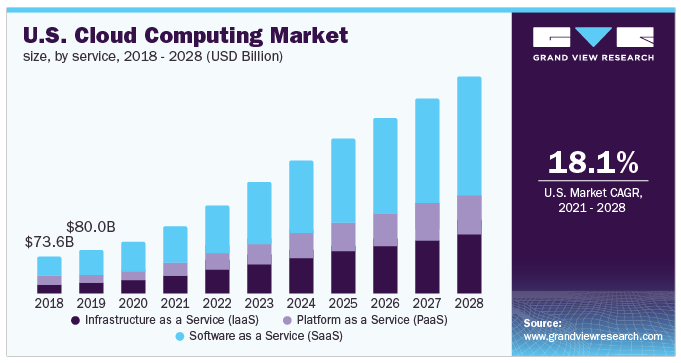
Fig: U.S. Cloud Computing Market, Source – Grand View Research
What these reports signify is a steady adoption of cloud services by businesses across the world to tackle the entire range of operations they do. Application development in cloud computing provides an extensive, flexible, and affordable way to implement cloud service models. Meanwhile, numerous leading players in the information technology sector now compete to deliver flexible cloud services for both the public and enterprises.
Increasing competition means better delivery of services and innovations, which can deeply benefit scaling up your business. Hence, now is the right time to deploy a cloud model into your business infrastructure.
What’s Ahead?
- Why does your business need Cloud Computing?
- What are Cloud Service Models?
- Adopting Cloud – Choosing between SaaS, IaaS, and PaaS
- SaaS
- IaaS
- PaaS
- What should you know about DaaS?
- Why is it important to choose the right Cloud Service Model?
- How can Cloud support your Custom Software needs?
- Cloud Service Models SaaS, IaaS, or PaaS: What fits your business?
Why Does Your Business Need Cloud Computing?
You must be wondering! Why do you need to adopt cloud service for your enterprise and what could it possibly do to widen the scope of your operations? Well, the pros of cloud adoption far outweigh its cons, which is one reason why you should consider it in the first place. Here are 3 major advantages of cloud adoption.
Scalable – A cloud service allows quick scaling up and down of computing resources to accommodate your changing needs.
Affordable – You pay less for a cloud service, as it eliminates unnecessary costs involved in hardware upgrades and maintenance.
Secure – By signing up for a cloud service, you are essentially making your data more secure using their industry-grade security protocols.
If you have envisioned a goal of making your business more dynamic, then the cloud is the way. And the question comes down to this: what type of cloud service model would you implement and which one will fit your unique business requirements?
Read more: How InfinCE, an integrated cloud platform, simplifies business management & collaboration!
What are Cloud Service Models?
Cloud computing services come mainly in three types of service models: SaaS (Software as a Service), IaaS (Infrastructure as a Service), and PaaS (Platform as a Service). Each of the cloud models has its own set of benefits that could serve the needs of various businesses.
Choosing between them requires an understanding of these cloud models, evaluating your requirements, and finding out how the chosen model can deliver your intended set of workflows.
The following is a brief description of the three types of cloud models and their benefits.
1. SaaS
SaaS or Software as a Service is a model that gives quick access to cloud-based web applications. The vendor controls the entire computing stack, which you can access using a web browser. These applications run on the cloud and you can use them by a paid licensed subscription or for free with limited access.
SaaS does not require any installations or downloads in your existing computing infrastructure. This eliminates the need for installing applications on each of your computers with the maintenance and support taken over by the vendor. Some known examples of SaaS include Google G Suite, Microsoft Office 365, Dropbox, etc.
2. IaaS
IaaS or Infrastructure as a Service is basically a virtual provision of computing resources over the cloud. An IaaS cloud provider can give you the entire range of computing infrastructures such as storage, servers, networking hardware alongside maintenance and support.
Businesses can opt for computing resources of their requirement without the need to install hardware on their premises. Amazon Web Services, Microsoft Azure, and Google Compute Engine are some of the leading IaaS cloud service providers.
3. PaaS
Platform as a Service or PaaS is essentially a cloud base where you can develop, test, and organize the different applications for your business. Implementing PaaS simplifies the process of enterprise software development. The virtual runtime environment provided by PaaS gives a favorable space for developing and testing applications.
The entire resources offered in the form of servers, storage, and networking are manageable either by the company or a platform provider. Google App Engine and AWS Elastic Beanstalk are two typical examples of PaaS. PaaS is also subscription-based and gives you flexible pricing options depending on your business requirements.
Adopting Cloud – Choosing Between SaaS, IaaS, and PaaS

Going through the details of what SaaS, PaaS, and IaaS may have given you a general understanding of these three cloud models. Each of them differs and has a range of advantages and disadvantages that may or may not fit in with your business model.
By correlating each of these cloud models side by side, you could derive a conclusion on whether it suits your business requirements.

SaaS
Benefits:
- Affordable – SaaS is affordable as it eliminates the costs involved in the purchase, installation, maintenance, and upgrades of computing hardware.
- Anywhere Accessibility – With SaaS, you can access the services from anywhere using any device such as smartphones, which eliminates the constraints set by on-premise software.
- Ready to Use – You can quickly set up SaaS services so that they become functional in no time. All it takes is that you sign up for the service to get access to fast and powerful computing resources.
Why Should One Opt SaaS?
With SaaS, communication, transferring of content, and scheduling meetings are made easy. SaaS is the ideal choice for small-scale businesses that do not have the necessary budget and resources to deploy on on-premise hardware. Besides, companies that require frequent collaboration on their projects will find SaaS platforms useful.
Studies reveal that Supply Chain Management, Business Intelligence, Enterprise Resource Planning (ERP), and Project and Portfolio Management will see the fastest growth in end-user spending on SaaS applications, through 2022.
Things to Consider Before SaaS Implementation
- Opt for configuration over customization within a SaaS-based delivery model. The configuration will allow you to tailor without changing the core product, whereas, customization will make it challenging to scale with the constant updates and documentation.
- Understand the adoption and usage rates carefully, and set clear objectives to be achieved with the SaaS adoption.
- Compliment your SaaS solution with integrations, and security options to make it more user-initiated.
Read more: Top Trends That Will Transform Cloud Computing in 2020 and Beyond!
IaaS
Benefits:
- Minimize Costs – Deploying an IaaS cloud model eliminates the need to deploy on-premise hardware that reduces the costs.
- Enhanced Scalability – As the most flexible cloud computing model, IaaS allows you to scale the computing resources up or down based on demand.
- Simple Deployment – IaaS lets you easily deploy the servers, processing, storage, and networking to make it up and running in no time.
Why Should One Opt IaaS?
IaaS being the most flexible of cloud models gives the best option when it comes to IT hardware infrastructure. IaaS is the right option if you need control over the hardware infrastructure such as managing and customizing according to your requirements.
Whether you are running a startup or a large enterprise, IaaS gives access to computing resources without the need to invest in them separately. However, the only downside with IaaS is that it is much costlier than SaaS or PaaS cloud models.
According to Gartner’s latest report, the worldwide infrastructure-as-a-service (IaaS) market grew 31.3% in 2018 to total $32.4 billion, and in 2019 it’s projected to be worth $38.9 billion. This growth will continue well into 2022, where it’s expected to be worth $76.6 billion.
Things to Consider Before IaaS Implementation
- Clearly define your access needs and the bandwidth of your network to facilitate smooth implementation and function.
- Plan out thorough data storage and security strategy to streamline the process.
- Ensure a disaster recovery plan so that your data remains safe and accessible at all means.
PaaS
Benefits:
- Minimal Development Time – PaaS reduces the development time since the vendor provides all computing resources like server-side components, which simplifies the process and improves the focus of the development team.
- Multiple Programming Language Support – PaaS offers support for multiple programming languages, which a software development company can utilize to build applications for different projects.
- Enhanced Collaboration – With PaaS, your business can benefit from having enhanced collaboration, which will help integrate your team dispersed across various locations.
Why Should One Opt PaaS?
PaaS is the preferred option if your project involves multiple developers and vendors. With PaaS, it is easy to create customized applications as it leases all the essential computing and networking resources. Being a different model, PaaS simplifies the app development process that minimizes your organizational costs.
Besides, it is flexible and delivers the necessary speed in the process, which will rapidly improve your development times. A typical disadvantage with PaaS is that since it is built on virtualized technology, you will have less control over the data processing. In addition, it is also less flexible compared to the IaaS cloud model.
A study by Market Reports World estimates that the global PaaS market will grow at a CAGR of 24.17% during 2019-2023 and will get valued at 28.4 billion USD by the end of 2023.
Things to Consider Before PaaS Implementation
- Crucially analyzing your business needs, decide the automation levels, if it needs to be self-service or fully automated.
- Clearly determine whether to deploy on a private or public cloud.
- Plan through the customization, and efficiency levels.
What Should You Know About DaaS?
Desktop as a Service or DaaS is desktop virtualization provided through the cloud. DaaS is similar to the server deployment done in IaaS. However, it strictly specializes to offer desktop operating systems. As mentioned earlier in this blog, according to Gartner, DaaS is expected to have the most significant growth in the coming years, analyzing the 95.4% increase in Worldwide Public Cloud Service Revenue in 2020.
Providing device accessibility from anywhere and at any time, DaaS enables workforce mobility and enhances flexibility. Its offerings are mostly simple pay-as-a-go subscription models which makes it easy to scale up. With DaaS, an organization can rely on data security, disaster recovery, optimum performance, cost savings, and mobility. Enabling an easy to manage and simplified IT environment for desktop solutions, DaaS is now widely adopted amongst small businesses.
Benefits:
- Security – Along with easy accessibility and simplified management of desktops and applications, DaaS ensures enhanced security of data.
- Flexibility – As mentioned earlier, DaaS enables easy accessibility from anywhere allowing maximum flexibility. Seasonal or remote workers and contract employees can stay productive at all times with streamlined access to applications, remote desktops, and data on any cost-effective device.
- Cost savings – Providing easy monthly and yearly subscription plans, DaaS reduces the capital expense and makes operational expenses more predictable.
- Business continuity – Providing disaster recovery support, and easy access to apps and desktops to the workforce, DaaS helps running a business at all times, even during natural disasters and pandemics.
Why is it Important to Choose the Right Cloud Service Model?
The rise in remote work culture is increasing the need for streamlined collaboration and secured storage facilities. Cloud computing is one technology that has the potential to drive efficiency and opportunities for companies functioning remotely, that too without the need for significant capital investment. It goes without saying that the Cloud is rightly the superhero in town now! However, it is essential to choose the right cloud service model to truly gain the advantage and remain competitive in the market.
The ultimate requirement of enterprises today is to quickly adapt to the growing market changes and to meet the rising consumer demands. Achieving this is however not possible without leveraging the emerging technology, which is quite complex in itself. But implementing the right Cloud Service Model, that fits the business objectives, enterprise infrastructure needs, provides the right flexibility to scale, adapts easily to the company process, products, and service techniques will amplify and smoothen transformation for business, that stands imperative today!
How Can Cloud Support Your Custom Software Needs?
Although the Cloud is highly adopted for cost-effective IT operation needs, the cloud’s capabilities and offerings are now not limited to data storage for the ease of system restoration. Cloud has now the ability to run a company’s IT operations in bulk including setting up and running an environment for custom software development. The Cloud Service Models Infrastructure as a Service (IaaS), and Platform as a Service (PaaS), have just the capabilities to provide an ecosystem to custom software applications.
Find out which cloud service model fits better for your custom software development needs from the infographic below:
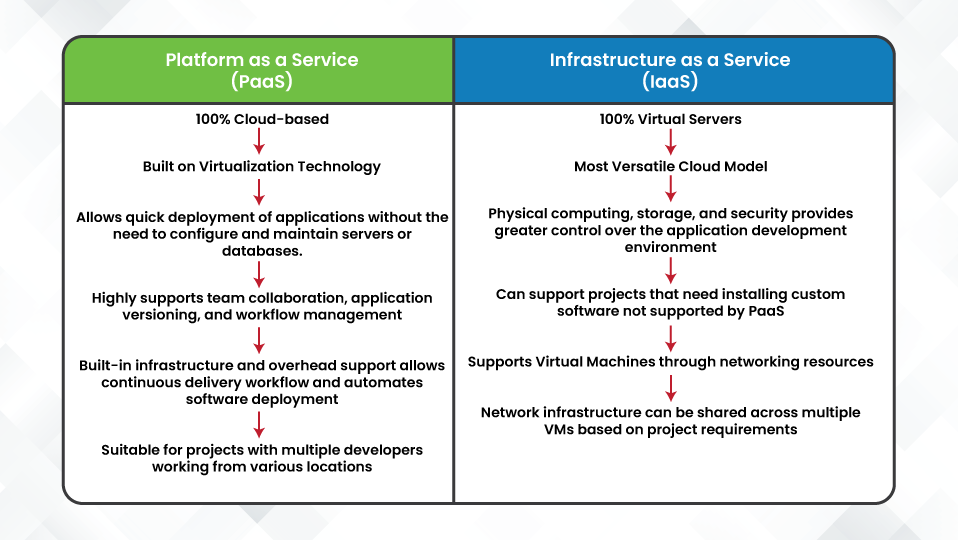
Cloud Service Models SaaS, IaaS, or PaaS: What Fits your Business?
The growing adoption of cloud services is a sign of the rapidly changing business environment. The forecasts and reports shed light on how the cloud is going to become the primary computing resource for enterprises in times to come. So, that suggests that your business should quickly adopt a cloud platform to leverage its wide-reaching benefits and in turn help you grow.
But, what cloud model would be apt as a solution that delivers the results that you are looking for. The above-mentioned details about SaaS, IaaS, and PaaS may have provided you with a peek into the nature of these cloud models. Each of them differs and it is up to you to address your business requirements and select one that you find apt for your needs.
To summarize, SaaS would suit your business well if you need cloud-based software like email, CRM, and productivity tools. IaaS is the perfect option if you require a complete virtual computing platform with powerful resources. If your requirement is a platform to develop and test your software and applications, then it is better to opt for PaaS.
Get in touch with our experts today to know more about our cloud services.
Stay up to date on what's new

Featured Blogs
Stay up to date on
what's new



Talk To Our Experts
Top Healthcare Digitalization Trends To Look For In The New Normal
Healthcare digitalization is reshaping the way we interact with healthcare professionals, share medical data or make decisions related to treatment and outcomes. There are plenty of examples that substantiate the digitalization of healthcare today, such as Artificial Intelligence-powered medical devices, telemedicine, blockchain, remote-patient monitoring, and electronic health records.
The main aim of healthcare innovation is to streamline the medical professionals’ work, optimize medical software systems, reduce human errors, improve patient outcomes, and lower costs through integrated web and mobile experiences.
Read more: The Application and Impact of Information Technology in Healthcare
Let’s look at the state of healthcare digitalization in 2021 and beyond:
1. On-demand Healthcare Will Grow
With the COVID-19 pandemic restricting many people to remain indoors, more and more patients seek on-demand healthcare. It is convenient as it helps patients seek guidance at their own time and from anywhere they need it.
DMN3 reveals that patients obtain online medical information primarily for the following reasons:
- 77% for booking medical appointments
- 47% for searching information about doctors and healthcare professionals
- 38% for searching information about hospitals and medical facilities
That said, on-demand healthcare is rising due to the growth of the gig economy. Here, freelance professionals from various industries hire themselves out per job or ‘gig’ instead of sticking to one company.
Read more: Patient Engagement Platforms: 7 Must-have Features
Many online healthcare marketplaces link doctors directly with short-term tasks, making it easier for physicians to deliver patient care in specific circumstances based on their expertise and schedule. Simply put, doctors are becoming on-demand healthcare providers to meet the changing needs of their patients in a better way.
2. Big Data Will Be Used To Improve Healthcare Management
Big data is the information gathered from various platforms such as eCommerce, social media, online transactions, and financial transactions. It helps identify patterns and trends for future use.
Read more: 5 Ways Big Data is Changing the Healthcare Industry
For healthcare, big data offers benefits such as:
- Reduced medication errors: Patient record analysis allows the healthcare software to flag any inconsistencies between a patient’s health and drug prescriptions. This alerts the health professionals and patients in case there is a potential risk of a medication error.
- Simplifying preventive care: Many recurring patients stepping into emergency rooms are “frequent flyers.” These frequent flyers account for up to 28% of clinical visits. Big data analysis helps identify these recurring patients and create preventive plans to keep them from returning.
- Improved staffing: Using big data’s predictive analysis, hospitals and clinics can estimate future admission rates enabling these facilities to allocate proper staff to deal with the patient. This will help save money and reduce emergency room waiting time, especially when a facility is understaffed.
Case Study: How did a data analytics solution help NHS gain financial, clinical, and geographical insights to improve visibility over their KPIs? Read Now!
Big data analytics, visualization, and insights generation can improve healthcare operations management and transform the patient experience.
3. Virtual Reality Will Transform Medical Training & Care Delivery Models
Virtual Reality is one of the most outstanding healthcare digitalization trends that change the way patients are diagnosed, and medical residents are trained.
- VR in medical diagnosis & treatments: VR is increasingly used in treatment segments in healthcare, such as patient education, robotic surgery, physical and psychological therapy, etc. For instance, medical professionals can use VR to construct a 360° patient-specific video detailing how the surgery will help the patient cure and the consequent results. Virtual Reality has been found effective in treating anxiety, post-traumatic stress disorder, and stroke.
Case Study: Find how Fingent developed a unique mixed reality application for a leading university that enables users to identify people using facial recognition. Download Now!
- VR for medical training: Other uses of VR technology include doctors and medical residents using VR simulations to hone their skills (learning in near-real situations) and safely plan complicated surgeries. In addition, VR headsets are used post-surgery to encourage patients to exercise and follow physiotherapies. The technology also enables autistic children to learn and navigate the world.
- Growth of VR in the medical field: From startups to established pharma companies, everyone recognizes the role of VR in healthcare. Experts estimate that by 2025 the global virtual and augmented reality in healthcare will reach $5.1 billion market value. So, if you’re a healthcare company wanting to improve your digital marketing strategy, you should consider investing in VR.
Read more: How Virtual Reality Improves The Standards Of Medical Education And Training
Virtual Reality technology offers a powerful communication channel that allows you to understand customers’ needs better and virtually engage them with your products and services.
4. Wearable Medical Devices Will Enjoy A Wider Market
Another major healthcare digitalization trend is companies collecting their health data from medical devices such as wearables. Previously, most people would check in with their doctors only when something went wrong and were used to undergoing physical check-ups once a year. However, technology is changing that. Today, people highly focus on preventive maintenance and are interested in knowing about their health status frequently. This trend forces several healthcare companies to invest in wearable technology devices that allow patients or family members to track health vitals and seek medical aid when needed. Wearable medical devices enable up-to-date monitoring of high-risk patients and determine the likelihood of any severe health risk.
Experts estimate that the wearable medical device market value will cross USD 27,200 mn by 2023.
Following are some of the widely used wearable devices:
- Exercise trackers (Google Fit, Fitbit, etc.)
- Heart rate sensors (Samsung Heart Rate Sensor, Pulse Sensor, etc.)
- Sweat meters: to monitor blood sugar levels of diabetics
- Oximeters: to monitor the amount of oxygen carried in the blood
Wearable devices in healthcare offer the following benefits:
- Personalized healthcare experience: Medical devices help patients improve their health and give them a sense of ownership regarding personal healthcare management.
- Insurance pricing: Wearable devices provide insurers with insights that enable them to rate a patient’s risk for illness more accurately.
- Insurance incentives: Wearable devices allow patients to take preventive measures to improve their health. Such patients are more likely to obtain lower insurance premiums.
- Gamification opportunities: Fitness watches can help create competitive goals for users to achieve through diet, nutrition, and exercise.
Case Study: Read more about how Fingent helped create a fitness Regimen app for trainers.
5. Healthcare AI Investments Will Increase
By 2025, the healthcare AI-enabled tools market is expected to exceed $34 billion globally. This indicates that healthcare AI investments will peak soon as Artificial Intelligence is set to transform various segments in medicine.
AI-powered chatbots and virtual health assistants fulfill many roles in the healthcare industry, such as customer service representatives, diagnostic tools, or even therapists. Hence AI in healthcare is gaining immense popularity. According to a report published by MarketsandMarkets, the global healthcare chatbots market is estimated to reach $314.3 million by 2023.
Read more: 5 Leading Chatbot Use Cases Explained with Real-life Examples
That said, we can witness the real power of AI in diverse areas such as medical imaging, drug discovery, precision medicine, and genomics. For example, the first-ever drug designed by AI is showing some promise to help patients suffering from obsessive-compulsive disorder. The AI-made drug molecule, DSP-1181, is in clinical trials currently. Researchers and scientists expect that the use of AI will make drug development faster and more efficient.
Overall, AI is projected to bring USD 150 billion by 2026 in annual savings for the US healthcare economy. As start-ups are lapping up the opportunity, the number of active AI start-ups has increased 14 times since 2000.
Why Keep A Close Eye On These Healthcare Digitalization Trends
These five healthcare digitalization trends will spill over in the future as the industry will innovate and adapt to meet the patients’ demands. As a result, organizations that embrace healthcare digitalization will see dividends sooner.
Fingent helps you navigate the digital healthcare space and adapt to the ‘Next Normal’ with our transformative experiences. Our custom healthcare software solutions have helped many of the leading healthcare providers worldwide. Contact us to learn more about how your healthcare organization or clinic can leverage healthcare digitalization effectively.
Stay up to date on what's new

Featured Blogs
Stay up to date on
what's new



